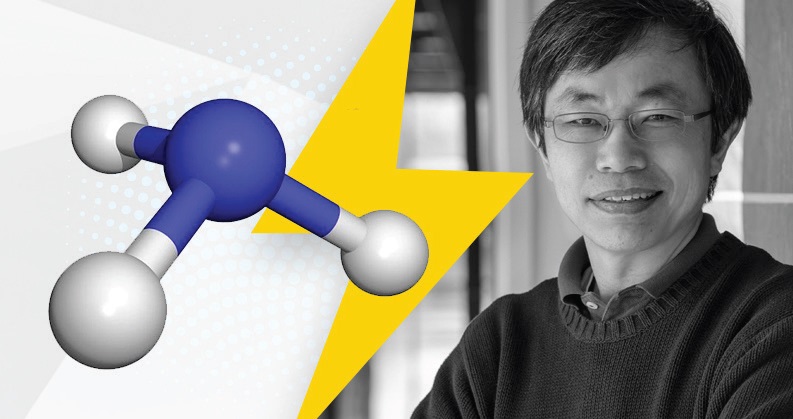KEY CONCEPTS
•
A technoeconomic analysis of greenhouse gas-neutral transportation fuels showed that ammonia has superior source-to-tank energy-cost compared to hydrogen and the carbon-based fuel methanol.
•
New approaches to improve the performance of a direct ammonia fuel cell include the use of a metal nitrogen carbon catalyst that is not negatively affected by ammonia.
•
The efficiency of the ammonia oxidation reaction was improved by adjusting electrolyte concentration and the temperature of the fuel cell.
Development of fuel cells has focused on maximizing the efficiency of the proton-exchange membrane-based type that uses hydrogen as the fuel and generates water. One of the significant challenges is improving the oxygen-reduction reaction occurring at the cathode.
Other fuel cell types also are evaluation. In a previous TLT article (
1), researchers working with a solid oxide fuel cell that uses a cathode based on four metals (lanthanide, strontium, cobalt and iron), determined that application of a multiphase catalyst on the cathode significantly improved performance and durability by minimizing strontium migration. The catalyst contained a combination of metal-based oxides that facilitated the movement of oxygen into the cathode.
But a fuel cell powered by hydrogen might not be the best option particularly to develop a carbon-neutral system. Working in the group of Yushan Yan, the Henry B. du Pont chair in chemical and molecular engineering at the University of Delaware in Newark, Del., Dr. Brian Setzler, postdoctoral associate, says, “While hydrogen can be efficiently converted in a fuel cell and produced at a low cost, issues involving transmission, distribution and high-pressure storage of this low-density gas are major drawbacks to using it in fuel cells.”
The difficulties in working with hydrogen led to the search for derivatives based on carbon. Setzler says, “Carbon-based fuels are readily available but cannot be made carbon-neutral without efficiently capturing carbon dioxide from the atmosphere. This process is not very efficient because carbon dioxide is present at a low concentration in air.”
Nitrogen-based fuels are an attractive option for use in fuel cells particularly if ammonia is considered (
see Figure 2). Setzler says, “Ammonia is a liquefiable fuel that is manufactured through a relatively low-cost, simple production process. This substance also contains 17.5% hydrogen by weight and does not require the use of a carbon-based fuel that will involve carbon dioxide.”
 Figure 2. The high percentage of hydrogen in the structure of ammonia and the low cost of this material make it a good candidate for use in fuel cells. (Figure courtesy of the University of Delaware.)
Figure 2. The high percentage of hydrogen in the structure of ammonia and the low cost of this material make it a good candidate for use in fuel cells. (Figure courtesy of the University of Delaware.)
When asked about concerns with dealing with the toxicity of ammonia, Setzler says, “This aspect of working with ammonia is an engineering challenge that we believe is manageable. One benefit is that ammonia is much less flammable than gasoline and hydrogen.”
Yan and his colleagues conducted a technoeconomic analysis of greenhouse gas-neutral transportation fuels and determined that ammonia has a superior source-to-tank energy-cost by a significant margin when compared to hydrogen and the carbon-based fuel, methanol. They found that ammonia has an 18% lower cost than methanol and a 31% cost than hydrogen.
The objective of their work is to develop an effective direct ammonia fuel cell (DAFC) where energy is generated by the direct transfer of hydroxide ions (produced at the cathode) as they cross a hydroxide conducting polymeric membrane. Ammonia is oxidized at the anode at the same time.
Dr. Yun Zhao, research associate at the University of Delaware, indicates that DAFC has been hampered by lower power output. He says, “DAFCs have often produced power densities less than 10 milliwatts per square centimeter.”
Yan and his colleagues have now made additional progress in developing a more effective direct ammonia fuel cell.
Metal nitrogen carbon catalyst
The researchers have prepared new approaches to deal with two of the biggest issues facing DAFCs—ammonia crossover and the ammonia oxidation reaction. Ammonia can cross over through the hydroxide exchange membrane from the anode to the cathode and negatively impact the oxygen reduction reaction.
Zhao says, “The conventional oxygen reduction reaction catalyst, platinum/carbon is adversely affected by the presence of ammonia leading to a loss of cell efficiency and power. We have identified a commercial catalyst known as a metal nitrogen carbon catalyst that is very effective in the oxygen reduction reaction and does not oxidize ammonia. The catalyst contains 3.5 weight percent of a transition metal catalyst on a carbon support.”
In fuel cell experiments, this catalyst supported a cell voltage roughly 50 millivolts higher than the platinum/carbon catalyst over the full range of the operating current. The improvement corresponds to a gain in voltage efficiency of 4-5 percentage points.
The researchers adjusted the concentration of the electrolyte and the temperature of the fuel cell to improve the efficiency of the ammonia oxidation reaction. Zhao says, “We found that optimizing the concentration of the potassium hydroxide electrolyte and raising the temperature to 80 C led to a peak power density of 135 milliwatts per square centimeter. A platinum/iridium catalyst was used to facilitate ammonia oxidation.”
Yan indicated that further work is needed to develop a commercially viable ammonia fuel cell. He says, “We will be working to identify a more effective ammonia oxidation catalyst.”
Additional information can be found in a recent paper (
2) or by contacting Yan at
yanys@udel.edu.
REFERENCES
1.
Canter, N. (2018), “Enhancing the rate of the oxygen reduction in fuel cells,” TLT,
74 (6), pp. 22-23.
2.
Zhao, Y., Setzler, B., Wang, J., Nash, J., Wang, T., Xu, B. and Yan, Y. (2019), “An Efficient Direct Ammonia Fuel Cell for Affordable Carbon-Neutral Transportation,”
Joule, DOI:
https://doi.org/10.1016/j.joule.2019.07.005.
.